Iron Condors are in Season

Iron Condors are in Season
By:Kai Zeng
Supercharge your returns in slightly bullish, low volatility markets
- Selling a short call and a put spread is called an iron condor.
- Investors favor the iron condor trading strategy in high implied volatility markets.
- Wider iron condors generally perform better in bull markets, while tighter iron condors offer more stable returns and volatility in bear markets.
The world of options is complex and constantly changing, offering traders a variety of strategies and techniques. One of the most popular strategies, the iron condor, is favored in high implied volatility environments. However, with the current market exhibiting its lowest level of implied volatility since the onset of the COVID pandemic, options traders who rely on volatility-selling strategies, such as the iron condor, are facing challenges.
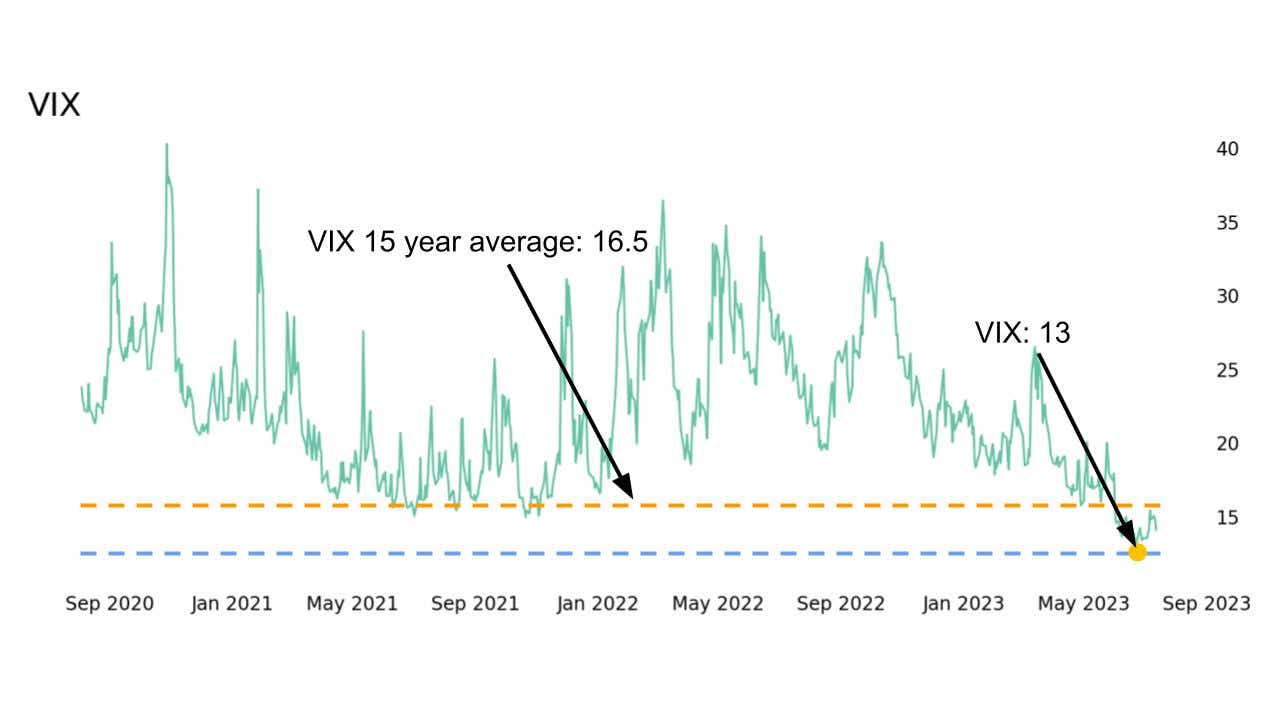
The iron condor involves simultaneously selling a short call and a put spread, making it most advantageous when volatility is high. In low implied volatility markets like the current one, premiums decrease and the profit zone narrows. This raises the question of whether it is wise to avoid iron condor trading altogether until implied volatility increases, or if alternative approaches can enhance the success rate and return on capital for such trades.
The condor's wings
One important factor that affects the risk and reward of iron condors in low volatility markets is the width of the wings. The wings refer to the difference between the long and short strike. Opting for wider wings creates a position similar to a synthetic strangle, allowing for greater price movement before becoming unprofitable. In contrast, narrower wings limit the maximum potential loss in a single position, effectively reducing tail risk. The choice between wider or narrower wings for an iron condor in a low implied volatility market is a consideration worthy of exploration.
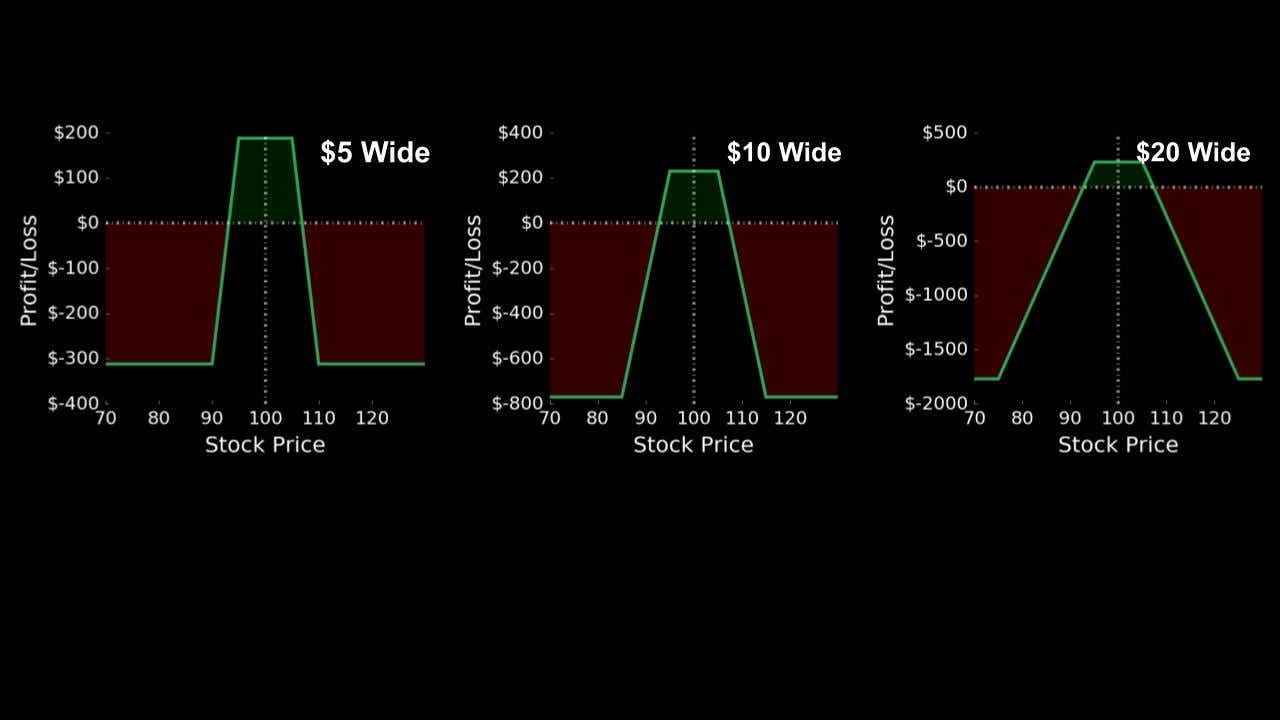
To shed light on this matter, we conducted two quantitative studies using an extensive historical dataset. Our research focused on options with 45 days-to-expiration (DTE) in SPY, where we sold the 25 delta strangles and purchased wings with widths of $5, $10 and $20 in these three strategies.
Testing the condor
The first test compared the results in high and low implied volatility markets. We used a 25% implied volatility rank (IVR) as the threshold to define the level of implied volatility. Generally, an IVR above 25% indicates a higher implied volatility level with rich premium in options.
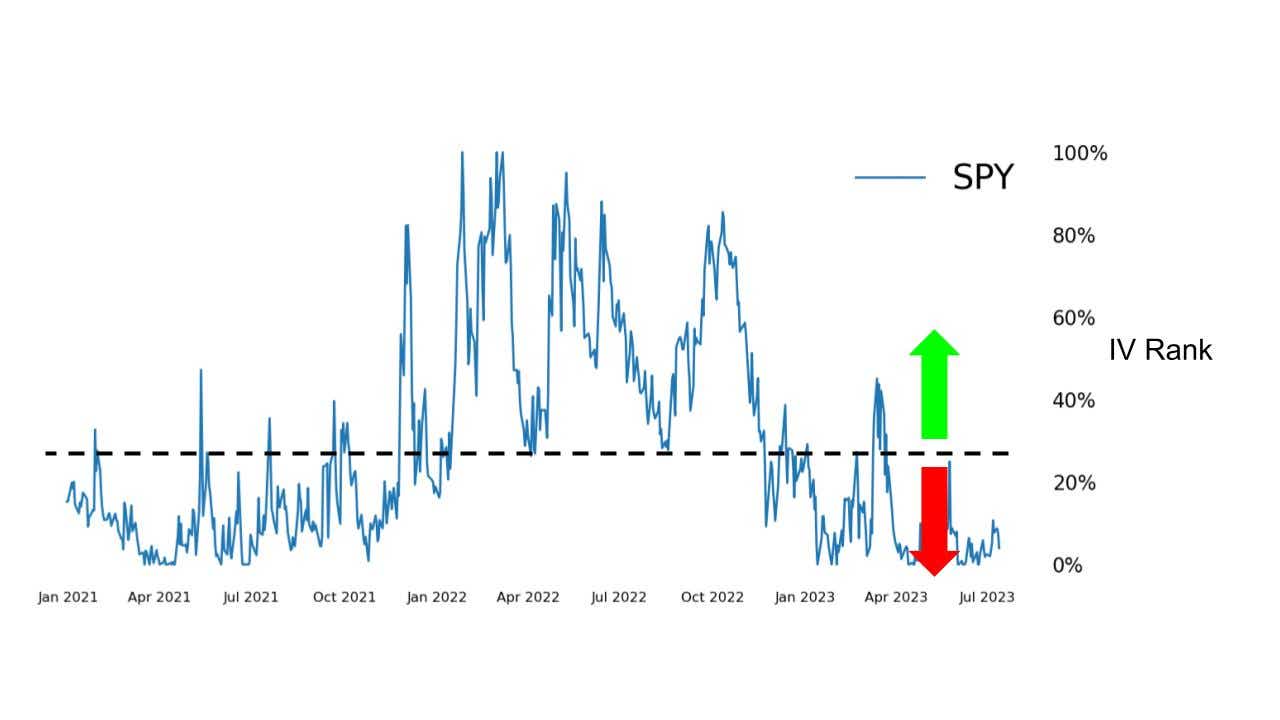
As expected, iron condors performed better in high implied volatility markets, with a slightly higher success rate, improved return on capital and better volatility control. Additionally, iron Condors with wider wings ($10, $20 wide) outperformed their narrower counterparts in all metrics, giving us more confidence in using these wider and larger strategies in a slow-moving market.
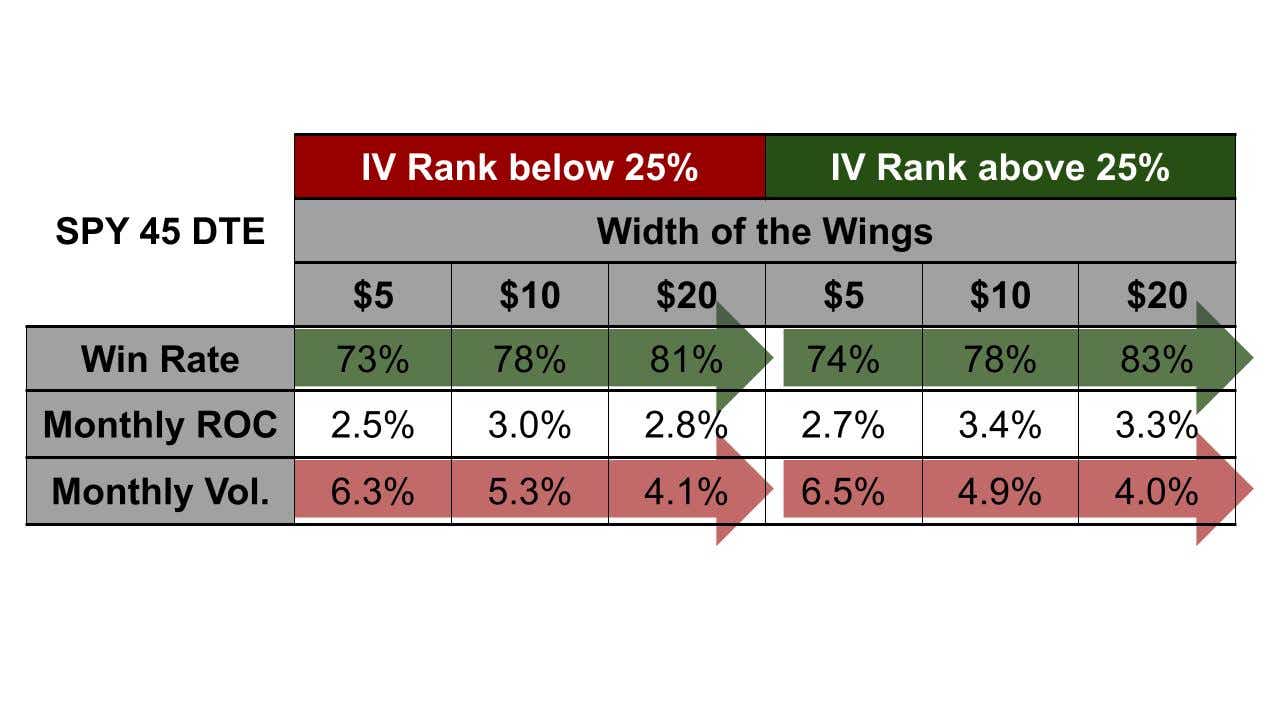
Because a slow grinding bull market often leads to decreasing implied volatility, as we observed between 2013 and 2018, we also tested the performance of iron condors in both bull and bear markets from 2005 to the present. The chart below defines the bullish and bearish years, and there have been a total of six major market drawdowns.
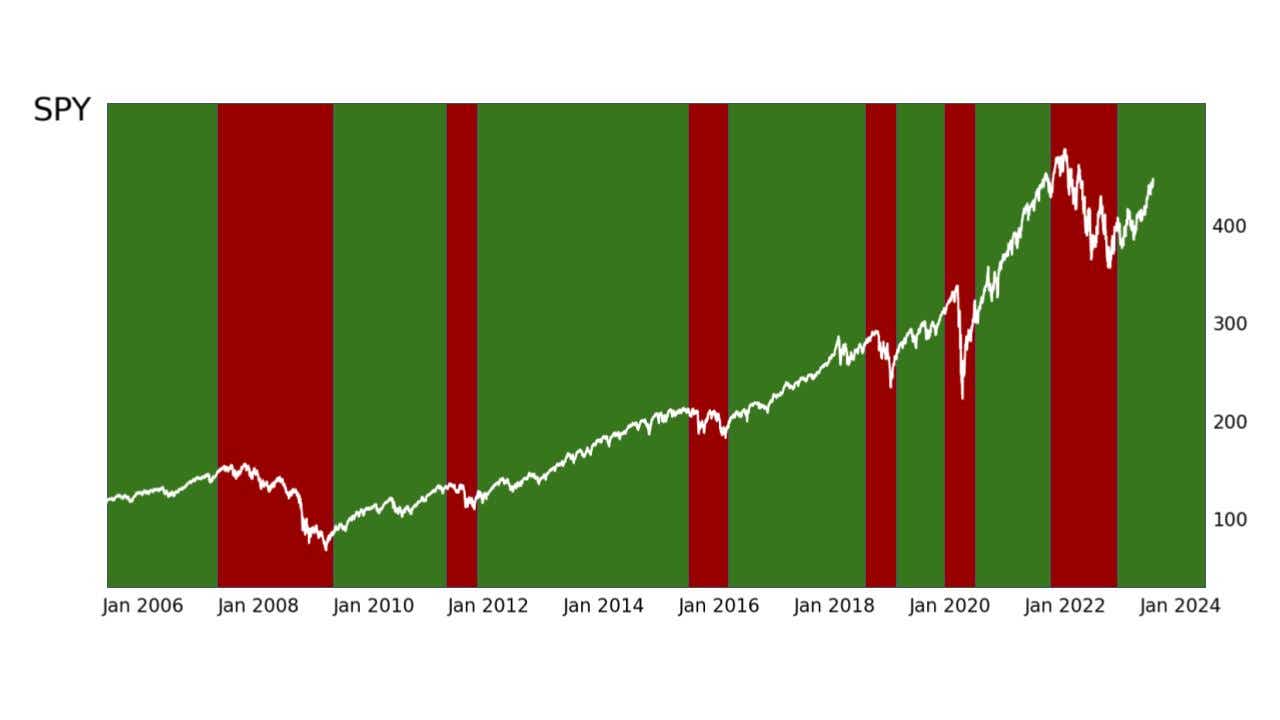
Iron condors showed less consistency between bull and bear markets. Wider iron condors generally performed better in bull markets, while tighter iron condors offered more stable returns and volatility in bear markets. In a slightly bullish market with decreasing implied volatility, using wider iron condors can consistently yield higher success rates, better returns and reduced volatility. Narrow iron condors are generally not preferred in most markets because of their limited profitability, especially in this case.
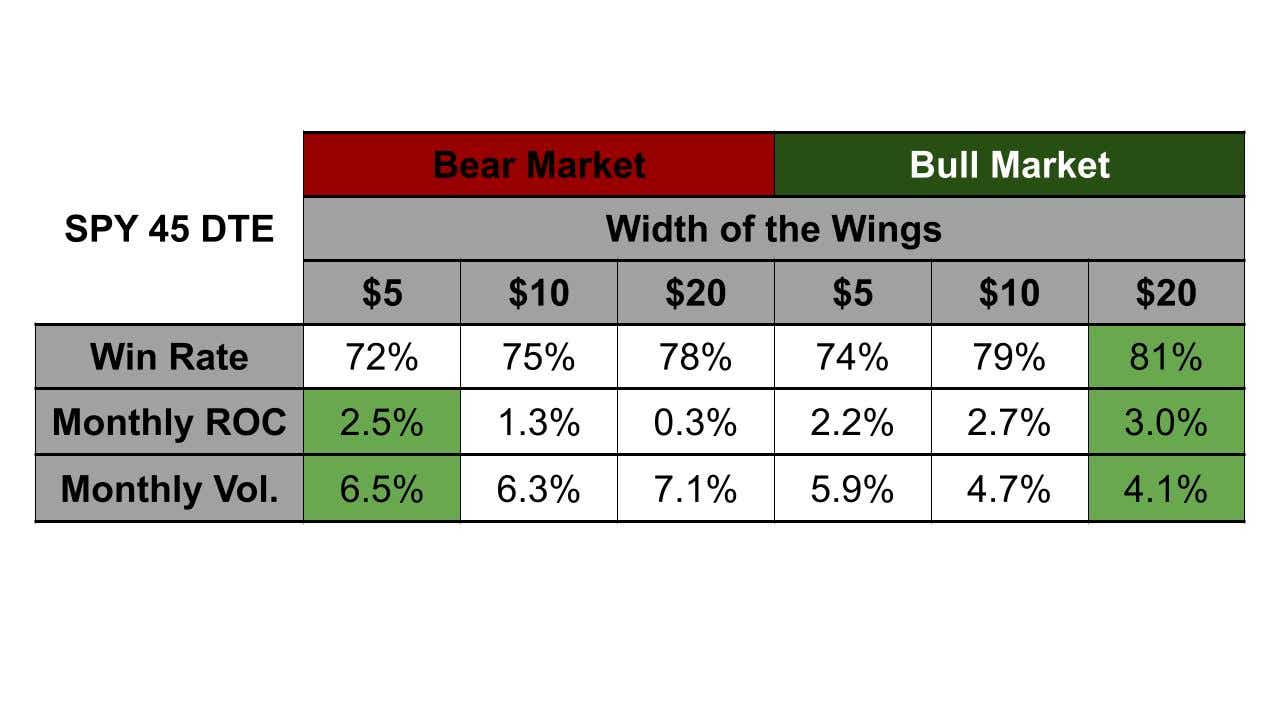
Understanding the dynamics of iron condors, particularly in low volatility markets, is crucial for traders. The market can continue to inch higher with low implied volatility for extended periods, sometimes years. The width of the wings, the implied volatility rank and the market conditions all play key roles in the performance of this strategy. Wider iron condors offer the most reliable and consistent returns regardless of IV Rank. However, in a low volatility market, choosing a wider iron condor is the smarter choice.
For more on iron condors in low IV markets, watch the video below.
Kai Zeng, director of the research team and head of Chinese content at tastylive, has a 20-year background in derivatives trading and market experience. He cohosts multiple live shows, including From Theory to Practice and Building Blocks. @kai_zeng1
For live daily programming, market news and commentary, visit tastylive or the YouTube channels tastylive (for options traders), and tastyliveTrending for stocks, futures, forex & macro.
Trade with a better broker, open a tastytrade account today. tastylive, Inc. and tastytrade, Inc. are separate but affiliated companies.
Options involve risk and are not suitable for all investors. Please read Characteristics and Risks of Standardized Options before deciding to invest in options.
tastylive content is created, produced, and provided solely by tastylive, Inc. (“tastylive”) and is for informational and educational purposes only. It is not, nor is it intended to be, trading or investment advice or a recommendation that any security, futures contract, digital asset, other product, transaction, or investment strategy is suitable for any person. Trading securities, futures products, and digital assets involve risk and may result in a loss greater than the original amount invested. tastylive, through its content, financial programming or otherwise, does not provide investment or financial advice or make investment recommendations. Investment information provided may not be appropriate for all investors and is provided without respect to individual investor financial sophistication, financial situation, investing time horizon or risk tolerance. tastylive is not in the business of transacting securities trades, nor does it direct client commodity accounts or give commodity trading advice tailored to any particular client’s situation or investment objectives. Supporting documentation for any claims (including claims made on behalf of options programs), comparisons, statistics, or other technical data, if applicable, will be supplied upon request. tastylive is not a licensed financial adviser, registered investment adviser, or a registered broker-dealer. Options, futures, and futures options are not suitable for all investors. Prior to trading securities, options, futures, or futures options, please read the applicable risk disclosures, including, but not limited to, the Characteristics and Risks of Standardized Options Disclosure and the Futures and Exchange-Traded Options Risk Disclosure found on tastytrade.com/disclosures.
tastytrade, Inc. ("tastytrade”) is a registered broker-dealer and member of FINRA, NFA, and SIPC. tastytrade was previously known as tastyworks, Inc. (“tastyworks”). tastytrade offers self-directed brokerage accounts to its customers. tastytrade does not give financial or trading advice, nor does it make investment recommendations. You alone are responsible for making your investment and trading decisions and for evaluating the merits and risks associated with the use of tastytrade’s systems, services or products. tastytrade is a wholly-owned subsidiary of tastylive, Inc.
tastytrade has entered into a Marketing Agreement with tastylive (“Marketing Agent”) whereby tastytrade pays compensation to Marketing Agent to recommend tastytrade’s brokerage services. The existence of this Marketing Agreement should not be deemed as an endorsement or recommendation of Marketing Agent by tastytrade. tastytrade and Marketing Agent are separate entities with their own products and services. tastylive is the parent company of tastytrade.
tastyfx, LLC (“tastyfx”) is a Commodity Futures Trading Commission (“CFTC”) registered Retail Foreign Exchange Dealer (RFED) and Introducing Broker (IB) and Forex Dealer Member (FDM) of the National Futures Association (“NFA”) (NFA ID 0509630). Leveraged trading in foreign currency or off-exchange products on margin carries significant risk and may not be suitable for all investors. We advise you to carefully consider whether trading is appropriate for you based on your personal circumstances as you may lose more than you invest.
tastycrypto is provided solely by tasty Software Solutions, LLC. tasty Software Solutions, LLC is a separate but affiliate company of tastylive, Inc. Neither tastylive nor any of its affiliates are responsible for the products or services provided by tasty Software Solutions, LLC. Cryptocurrency trading is not suitable for all investors due to the number of risks involved. The value of any cryptocurrency, including digital assets pegged to fiat currency, commodities, or any other asset, may go to zero.
© copyright 2013 - 2025 tastylive, Inc. All Rights Reserved. Applicable portions of the Terms of Use on tastylive.com apply. Reproduction, adaptation, distribution, public display, exhibition for profit, or storage in any electronic storage media in whole or in part is prohibited under penalty of law, provided that you may download tastylive’s podcasts as necessary to view for personal use. tastylive was previously known as tastytrade, Inc. tastylive is a trademark/servicemark owned by tastylive, Inc.